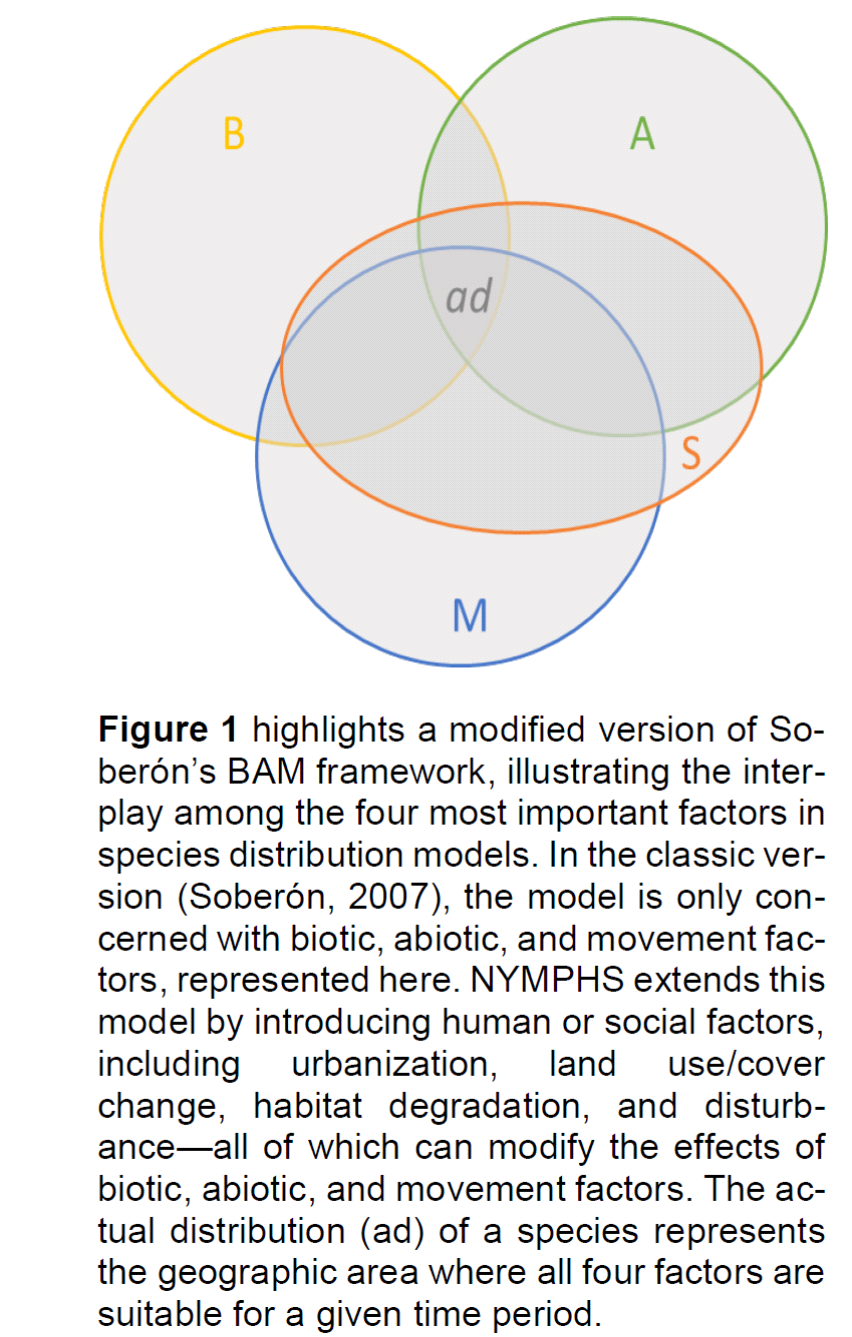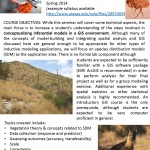I joined Janet Franklin (UC-Riverside), Shawn Laffan (University New South Wales), & Andrew Skidmore (University of Twente) to edit a special issue on Spatial Ecology in IJGIS, “Modeling movement, distributions, diversity, and disturbance.”
Category: species distribution models
Post-doc opportunity in SDM
Opportunity: 1-3 years post-doctoral position using species distribution models to track movement of pollen. This opportunity will be in the Geography Department at UT-Austin but part of a collaborative project with the Biology Department at UT, Arizona State University, and Emory University.

Responsibilities: This (potentially) 5 year project is focused on forensic palynology (NYMPHS) The post-doc position will primarily be involved in developing models that incorporate ‘movement’ (dispersal, accessibility) and human impacts, in addition to biotic and abiotic factors (see figure 1) in order to model the distribution of pollen and pollinators. Ultimately, we are interested in developing a geocomputation toolbox that is capable of predicting the movement paths of forensic pollen samples over space and time.
Experience: Ideal candidates will have PhD in Geography, Ecology/Biology, or similar discipline with excellent statistical and data management skills. In particular, we are looking for candidates with extensive experience using R for species distribution models (preferably experience using BIOMOD2 or similar ensemble forecasting package). Additional experience and interest in pollen/pollinator networks, data science, and/or GIScience is preferred. Candidate should also have a strong publication record and ability to work in a collaborative research environment.
Location: The University of Texas at Austin, one of the biggest and best research universities in the world, is located in the dynamic capitol city of Austin, recently named the best place to live in America for the 2nd year in a row. The position will be in the Department of Geography and the Environment.
More information: Start date can be as soon as March 2020 (negotiable). To apply, please send a single .PDF document with your CV, cover letter outlining your relevant experience and when you could start, and names and contact information for three references. For more information, contact Jennifer A Miller
New project on Forensic Palynology
Jennifer is one of six PIs on a new MURI-funded project on ‘Multi-layer Network Modeling of Plant and Pollen Distribution across Space’ (NYMPHS). The purpose of this research program is to make forensic palynology via metabarcoding a key operational contributor to national security by equipping the DoD with a set of reliable, globally validated, easy-to-use geocomputational tools, mathematical models, and SDMs for geolocating pollen samples.
Jennifer invited to give seminar at University of Amsterdam
I was invited to give a seminar at the Institute of Biodiversity and Ecosystem Dynamics (IBED) at the University of Amsterdam. The visit coincided with King’s Day, a national holiday to celebrate the King’s birthday.
Special Issue on Spatial Ecology in IJGIS
CFP for the 5th special issue on Spatial Ecology in International Journal of Geographical Information Science is announced.
Special Issue Editors:
Assoc Prof Jennifer Miller, University of Texas at Austin, USA;
Assoc Prof Shawn Laffan, University of NSW, Australia;
Prof Andrew Skidmore, ITC, University of Twente, The Netherlands;
Prof Janet Franklin, University of California-Riverside, USA
A 5th special issue on spatial ecology has been approved by the Editors and Publisher of the International Journal of GIS. You are encouraged to submit relevant and high quality manuscripts for this special issue (see details below). This special issue continues the tradition of Spatial Ecology publications in the IJGIS.
For this special issue, we are seeking the submission of papers from ecological and related environmental studies, as well as more technical articles including topics such as spatial data infrastructure relevant to ecological applications. We are especially interested in special and novel ways of addressing spatial ecology questions, managing spatial ecological data, and advancing open science in spatial ecology.
Key words and topics for this special issue include scale, geovisualization, spatial data infrastructure for ecological (biodiversity) data, methods to derive ancillary data required for ecological modeling (climate, terrain, soils etc), animal movement including both spatial and temporal analysis, phenology, global databases for ecological studies (biodiversity, NPP, carbon etc), fragmentation and connectivity, biodiversity hotspots and endemism, physical vegetation structure for biomass assessment, palaeoecology and reconstructing past environments with respect to climate change, innovative methods and models for spatial ecological analysis, and open science and new directions for spatial ecology research. Applications across terrestrial, marine and atmospheric ecology are welcome. Relevant cross-over papers between GIS and remote sensing will also be considered.
The deadline for submission of papers is 15-July-2018. The anticipated publication date will be in 2019.
Papers are to be submitted via http://mc.manuscriptcentral.com/ijgis. Please choose ‘Special Issue Paper’ from the Manuscript Types field when doing so.
Research collaboration with AIMS continues
Jennifer spent several weeks back in Perth, Western Australia continuing a collaboration with Drs. Ben Radford and Marji Puotinen at the Australia Institute of Marine Science. They focused on using geographically weighted regression to explore spatial accuracy of models of mixed benthos assemblages in the Northern Kimberley region and were able to squeeze in a writing retreat on Rottnest Island.

PiPG Progress Report
Another SDM-related progress report in Progress in Physical Geography is coming out. This one is on the use of simulated data to assess models.
Grad seminar on SDM
Progress report in PiPG
The first in a series of progress reports on species distribution models I’ve been invited to contribute to Progress in Physical Geography was published in 2012. This report focused on spatial autocorrelation and nonstationarity (doi: 10.1177/0309133312442522), the second one is on using simulated data (estimated publication in early 2014).
